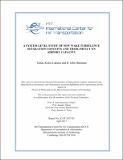A System Level Study of New Wake Turbulence Separation Concepts and Their Impact on Airport Capacity
Author(s)
Kolos-Lakatos, Tamas; Hansman, R. John
DownloadICAT_Report_201703_TamasKolos-Lakatos.pdf (11.95Mb)
Metadata
Show full item recordAbstract
The air transportation industry continues to grow worldwide, but demand is often limited by available airspace and airport capacity. This thesis focuses on evaluating new air traffic procedures: specifically, new and emerging wake turbulence separation rules that could potentially increase runway capacity based on today’s knowledge of wake vortex turbulence and technological capabilities. While legacy wake separation rules establish aircraft-classes based on weight of aircraft, these new separation rules can define separation standards by considering other aircraft parameters and dynamic wind conditions.
A fast-time runway system model is developed for studying these wake separation rules,
using Monte-Carlo simulations, to provide accurate and realistic runway capacity estimates based on the randomness of arrival and departure operations. A total of nine new proposed wake separation rules are analyzed in detail, which include both distance-based and time-based methods, as well as static and dynamic concepts. Seven of the busiest and most delayed U.S. airports are selected as case studies for the illustration of runway capacity benefits enabled by these new wake separation rules: Boston (BOS), New York J.F. Kennedy (JFK), New York LaGuardia (LGA), Newark (EWR), San Francisco (SFO), Los Angeles (LAX), and Chicago O’Hare (ORD). For a detailed capacity analysis, the new wake separation rules are tested under the most constraining
runway configurations at each of these airports.
The results indicate that increasing the number of aircraft wake categories can increase
runway capacity, but the added benefits become smaller with each new category added. A five-or six-category wake separation system can capture most of the runway capacity that can be achieved with a static pair-wise system. Additionally, shifting wake category boundaries between airports as a function of local fleet mix can provide additional runway capacity benefits, meaning that airport specific wake separation rules can increase capacity over a universal separation rule system. Among the new wake separation rules, the results indicate that reducing wake separations further from current minimum separations (separation values of 2NM or less) can shift the operational
bottleneck from the approach path to the runway, as runway occupancy time becomes the limiting factor for inter-arrival separations. The findings from the time-based separation rule demonstrate that switching from distance-based separations to time-based separations in strong headwind conditions can recover significant lost capacity. Time-based separation rules can be of great value 4 to increase operational reliability and capacity predictability at airports in all weather conditions. Moreover, the results also indicate that a reduction in minimum separations enabled by dynamic wind and aircraft information can offer marginal runway capacity benefits over the capacity enabled by static pair-wise wake separations, as more and more aircraft pairs become limited by
runway occupancy time. Therefore, a joint effort is needed for reducing both wake separations and runway occupancy in order to accommodate future air traffic demand.
Date issued
2017-04-21Series/Report no.
ICAT;2017-03
Keywords
air transportation, air traffic procedures, wake turbulence